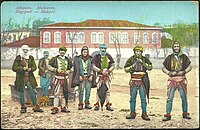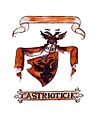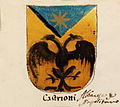House of Kastrioti
| House of Kastrioti | |
|---|---|
 | |
| Place of origin | a region between Mat and Dibër traditionally known as the Principality of Kastrioti |
| Members | Kostandin Kastrioti, Pal Kastrioti, Gjon Kastrioti, Skanderbeg (Gjergj Kastrioti), Hamza Kastrioti, Gjon Kastrioti II |
| Website | http://www.castriotascanderbeg.it/ |
The House of Kastrioti (Albanian: Dera e Kastriotëve) was an Albanian noble family, active in the 14th and 15th centuries as the rulers of the Principality of Kastrioti. At the beginning of the 15th century, the family controlled a territory in the Mat and Dibra regions. The most notable member was Gjergj Kastrioti, better known as Skanderbeg, regarded today as an Albanian hero for leading the resistance against Mehmed the Conqueror's efforts to expand the Ottoman Empire into Albania. After the fall of the Principality and Skanderbeg's death in 1468, the Kastrioti family gave their allegiance to the Kingdom of Naples and were given control over the Duchy of San Pietro in Galatina and the County of Soleto, now in the Province of Lecce, Italy.[1] Ferrante (died 1561), son of Gjon Kastrioti II, Duke of Galatina and Count of Spoleto, is the direct ancestor of all male members of the Kastrioti family today. Today, the family consists of two Italian branches, one in Lecce and the other in Napoli. The descendants of the House of Kastrioti in Italy use the family name "Castriota Scanderbeg".
History[]

A figure attested as Kastriot of Kanina in southern Albania who appears in a letter sent on September 2, 1368 by Alexander Komnenos Asen to the Ragusan senate has been hypothesised by a number of authors, mostly in the early 20th century, as an ancestor of the Kastrioti family. Heinrich Kretschmayr argued that this Kastriot may have been in fact Pal or Gjergj Kastrioti, John Fine considered it "probable" that this Kastriot was an ancestor of Gjon Kastrioti and Aleks Buda tried to bridge the geographical discrepancy between the Kastriot of Kanina who lived in southern Albania and the Kastrioti who were active in north-central Albania by arguing that after the fall of the Balšić, they returned to their ancestral lands in the Dibër valley.[2][3][4] In contemporary historiography, the figure recorded as Kastriot of Kanina in 1368 is considered to be unrelated to the Kastrioti family.[5] The Kastrioti so far remain absent from historical or archival records in comparison to other Albanian noble families until their first historical appearance at the end of the 14th century.[6]
| Part of a series on |
| Albanian tribes |
|---|
 |
The historical figure of Konstantin Kastrioti Mazreku is attested in Giovanni Andrea Angelo Flavio Comneno's Genealogia diversarum principum familiarum. Angelo mentions Kastrioti as Constantinus Castriotus, cognomento Meserechus, Aemathiae & Castoriae Princeps (Constantinus Castriotus, surnamed Meserechus, Prince of Aemathia and Castoria). The toponym Castoria toponym has been interpreted as Kastriot, Kastrat in Has, Kastrat in Dibra or the microtoponym "Kostur" near the village of Mazrek in the Has region.[7] In connection to the Kastrioti family name, it is very likely that the name of one the different Kastriot or Kastrat which were fortified settlements as their etymology shows (castrum) was as their family name. The Kastrioti may have originated from this village or probably had acquired it as pronoia.[8] Angelo used the cognomen Meserechus in reference to Skanderbeg and this link to the same name is produced in other sources and reproduced in later ones like Du Cange's Historia Byzantina (1680).[9] These links highlight that the Kastrioti used Mazreku as a name that highlighted their tribal affiliation (farefisni).[10] The name Mazrek(u), which means horse breeder in Albanian, is found throughout all Albanian regions.[11] The Kastrioti themselves where organised in a tribal structure and formed a fis or clan/tribe.[12]
Konstantin Kastrioti's son, who was the father of Gjon Kastrioti and grandfather of Skanderbeg, appears in two historical sources, Gjon Muzaka's Breve memoria de li discendenti de nostra casa Musachi (1510) and Andrea Angelo's Genealogia diversarum principum familiarum (1603/1610) who was later largely reproduced by Du Cange (1680). Angelo calls Gjon Kastrioti's father "Georgius Castriotus" (Gjergj), lord (princeps) of "Aemathiae, Umenestria" (Mat and probably Ujmisht) and "Castoriae". Muzaka calls him "Paulo Castrioto" (Pal) and asserts that "he ruled over no more than two villages, called Signa and Gardi Ipostesi" (Sinë and Gardhi i Poshtëm, in Çidhën of Dibër).[13] His first name is disputed. Neither name can be characterized as the correct version because of an extreme lack of sources. The name "Paulo" (Pal) is mentioned only by one author (Muzaka) and wasn't used as the name of any of his grandsons (Reposh, Konstantin, Stanisha, Gjergj) or great-grandsons (Giorgio, Costantino, Ferrante).[14]
His rule over "only two villages" as described by Muzaka has been disputed because if true, it would mean that his son, Gjon Kastrioti who ruled over a much larger area rose to power in the span of one generation. This is considered a very unlikely trajectory in the context of Albanian medieval society because noble families had acquired their area of influence over multiple generations.[15] Historian Kristo Frashëri considers it likely that he ruled over his region "in the third quartier of the 14th century" between 1350-75 based on the fact that when his grandson Gjergj Kastrioti was born, his son Gjon had already fathered eight children.[14]
His son, Gjon Kastrioti (died 1437), became the lord of Matia (Mat). He managed to expand his territory but was ultimately subdued by the invading Ottomans. The most notable member was Gjergj Kastrioti, better known as Skanderbeg (1405–1468), declared an Albanian national hero, renowned in Albanian folklore for uniting the Albanian principalities in a military and diplomatic alliance, the League of Lezhë, which fought against Mehmed the Conqueror's efforts to further expand the Ottoman Empire into Europe.
Titles[]
The list of titles used by Kastrioti family are:
Albania in the Middle Ages
- Lord or King of Albania
- Prince of Kruja (Principality of Kastrioti)
- Lord of Sina and Lower Gardi
- Lord of Emathia and Vumenestia
In Ottoman Empire
In the Kingdom of Naples
- Duke of San Pietro in Galatina
- Count of Soleto
- Signore of Monte Sant'Angelo
- Signore of San Giovanni Rotondo
- Baron of Gagliano
- Baron of
- Baron of Arigliano
Members[]
- Kostandin Kastrioti, possibly the father of Pal Kastrioti
- Pal Kastrioti - had the title "segnior de Signa et de Gardi-ipostesi" (Sina (Albanian: Sinë) and Lower Gardi (Albanian: Gardhi i Poshtëm)), three sons
- Aleks Kastrioti - lord of three villages, unknown issue
- Kostandin Kastrioti - Lord of Kruja castle (Latin: dominus Serinae), unknown issue
- Gjon Kastrioti (fl. 1407-1437†), married Voisava Tripalda, nine children
- Reposh Kastrioti - († 1430 or 1431),[16] unknown issue, possibly father of Constantine
- Stanisha Kastrioti - († 1445?), one son
- Hamza Kastrioti - (After 1457)
- , unknown issue, possibly father of Constantine
- Constantine Kastrioti
- Mara Kastrioti, married Stefan I Crnojević,[17] buried in Kom Monastery, three sons (Ivan, and )
 Skanderbeg (Gjergj Kastrioti) - Albanian national hero (d. 1468)
Skanderbeg (Gjergj Kastrioti) - Albanian national hero (d. 1468)
- Gjon Kastrioti II (d. 1501)- Count of Soleto, married Jerina Branković, daughter of despot Lazar Branković of Serbia
- Costantino Castriota (d. 1500), bishop of Isernia (fl. 1498)
- (d. 1561), duke of San Pietro in Galatina
- Maria (d. 1569)
- Giorgio (d. 1540), Venetian military (fl. 1499–1501)
- Gjon Kastrioti II (d. 1501)- Count of Soleto, married Jerina Branković, daughter of despot Lazar Branković of Serbia
- Jelena Kastrioti - married [17] with whom she had , Lord of Misia
- Mamica Kastrioti, married in 1445[17]
- Angelina Kastrioti, married
- Vlajka Kastrioti, married ,[17] secondly ,[18] two sons with Stefan[19] with whom she had and Gojko Balsha
- Pal Kastrioti - had the title "segnior de Signa et de Gardi-ipostesi" (Sina (Albanian: Sinë) and Lower Gardi (Albanian: Gardhi i Poshtëm)), three sons
Italian period[]

After the fall of Albania to the Ottoman Empire, the Kingdom of Naples gave land and noble title to Skanderbeg's family, the Kastrioti.[21] His family were given control over the Duchy of San Pietro in Galatina and the County of Soleto, now in the Province of Lecce in Italy.[1] His son, Gjon Kastrioti II, married Jerina Branković, daughter of Serbian Despot Lazar Branković and one of the last descendants of the Palaiologos.[1] Two patrilineal branches of the Kastrioti family exist today: the branch of Lecce with two sub-branches and the branch of Napoli with one sub-branch. Both branches are patrilineally descended from the sons of Ferrante (-1561), Duke of Galatina and Count of Spoleto.[22]
Armorials[]

Venetian Armorial (16th century)

Korenić-Neorić Armorial (1595)

Giacomo Fontana (1605)

Fojnica Armorial (1675-1688)

Jerónimo de Bolea (17th century)

Angelo Maria da Bologni (1715)
Footnotes[]
References[]
- ^ Jump up to: a b c Runciman 1990, pp. 183–185
- ^ Kretschmayr, Heinrich (1920). Geschichte von Venedig (in German). 2. Gotha: F.A. Perthes. p. 375. OCLC 39124645.
- ^ Buda 1986, p. 239.
- ^ Fine 1994, p. 357.
- ^ Omari 2014, p. 29
- ^ Omari 2014, p. 46.
- ^ Bela 2019, p. 229.
- ^ Omari 2014, p. 44
- ^ Malaj 2013, p. 43
- ^ Malaj 2013, p. 44
- ^ Malaj 2013, p. 45.
- ^ Gall, Timothy L.; Hobby, Janeen (2009). Worldmark Encyclopedia of Cultures and Daily Life: Europe. p. 27.
- ^ Omari 2014, p. 45
- ^ Jump up to: a b Omari 2014, p. 41
- ^ Muhaj 2015, p. 42.
- ^ Vuković, Novo (1996). Književnost Crne Gore od XII do XIX vijeka. Obod. p. 42.
Његов други син звани Репош, брат Бурђа Кастриота, умро је 1430. или 1431. године у Хиландару и тамо је ...
- ^ Jump up to: a b c d [1] p. 96
- ^ Noli, Fan Stilian (1947), George Castrioti Scanderbeg (1405–1468), International Universities Press, p. 64, OCLC 732882,
Vlajka me Stefan Stres Balshën
- ^ Gopčević, Spiridon (1914). Geschichte von Montenegro und Albanien (in German). Gotha: F.A. Perthes. p. 460. OCLC 9968504. Retrieved 29 March 2012.
Bezüglich der Strez herrscht Verwirrung. Hopf macht Ivo und Gojko BalSid zu Söhnen des Stefan Strez, welcher Vlajka Kastriota geheiratet hätte und Sohn des Gjuragj Balšić gewesen wäre, eines Bastards des Gjuragj I.
- ^ Nadin, Lucia (2013). Venezia e Albania: una storia di incontri e secolari legami. Regione del Veneto. p. 96. ISBN 978-88-97784-35-7.
- ^ Gibbon 1901, p. 467
- ^ "Official genealogical tree of the Kastrioti famly". Castriota-Scanderbeg.
Sources[]
- Bela, Muhamet (2019). "A ishte Skënderbeu nga Hasi?! - Mendime rreth origjinës së Skënderbeut". In Syla, Sabit; Verli, Marenglen; Asani, Skënder; Berisha, Gjon (eds.). Gjergj Kastrioti - Skënderbeu në 550-vjetorin e vdekjes: (materiale nga Konferenca shkencore ndërkombëtare "Gjergj Kastrioti - Skënderbeu në 550-vjetorin e vdekjes", mbajtur në Prishtinë, më 16 tetor 2018) (PDF) (in Albanian). Institute of history "Ali Hadri". ISBN 9951409806.
- Buda, Aleks (1986). Shkrime Historike. Shtëpia Botuese "8 Nëntori". ISBN 9992716517.
- Ducellier, Alain (1981). La façade maritime de l'Albanie au Moyen âge: Durazzo et Valona du XIe au XVe siècle. Ed. de l'Ècole des Hautes Études en Sciences Sociales.
- Fine, John (1994). The Late Medieval Balkans: A Critical Survey from the Late Twelfth Century to the Ottoman Conquest. University of Michigan Press. ISBN 978-0-472-08260-5.
- Hodgkinson, Harry (1999). Scanderbeg: From Ottoman Captive to Albanian Hero. London: Centre for Albanian Studies. ISBN 978-1-873928-13-4.
- Malaj, Edmond (2013). "Familje fisnike të Drishtit mesjetar (Noble Families of Medieval Drivasto". Studime Historike. 3–4.
- Muhaj, Ardian (2015). "Hulumtimi i origjinës së Skënderbeut përmes historisë së jetës dhe veprës së tij". 610-vjetori i lindjes së Heroit Kombëtar Gjergj Kastrioti Skënderbeu. Academy of Sciences of Albania.
- Omari, Jeton (2014). Scanderbeg tra storia e storiografia [Skanderbeg between history and historiography] (PDF) (Thesis). University of Padua.
External links[]
- I Castriota Scanderbeg (in Italian)
- Genealogical Tree
- House of Kastrioti





